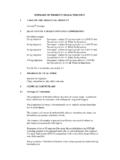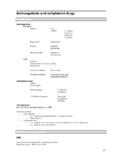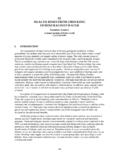Transcription of SUMMARY OF PRODUCT CHARACTERISTICS - Sanofi
1 SUMMARY OF PRODUCT CHARACTERISTICS 1. Name of the medicinal PRODUCT Epilim 100mg Crushable Tablets Epilim 200 Enteric Coated Tablets Epilim 500 Enteric Coated Tablets Epilim Liquid Epilim Syrup 2. Qualitative and quantitative composition Epilim 100mg Crushable: Each tablet contains 100mg of Sodium Valproate. Epilim 200 Enteric Coated: 200mg Sodium Valproate Epilim 500 Enteric Coated: 500mg Sodium Valproate Epilim Syrup and Liquid: 200mg Sodium Valproate per 5ml 3. Pharmaceutical form Epilim 100mg Crushable: Tablet Epilim 200 Enteric Coated: Enteric coated tablets Epilim 500 Enteric Coated: Enteric coated tablets Epilim Syrup: Syrup Epilim Liquid: Liquid 4. Clinical particulars Therapeutic indications In the treatment of generalized, partial or other epilepsy.
2 Posology and method of administration Epilim tablets, syrup & liquid are for oral administration. Daily dosage requirements vary according to age and body weight. Epilim tablets, syrup and liquid may be given twice daily. Uncoated tablets may be crushed if necessary. Epilim Liquid should not be diluted. In patients where adequate control has been achieved Epilim Chrono formulations are interchangeable with other conventional or prolonged release formulations on an equivalent daily dosage basis. Dosage Usual requirements are as follows: Adults Dosage should start at 600mg daily increasing by 200mg at three-day intervals until control is achieved. This is generally within the dosage range 1000mg to 2000mg per day, ie 20-30mg/kg/day body weight. Where adequate control is not achieved within this range the dose may be further increased to 2500mg per day.
3 Children over 20kg Initial dosage should be 400mg/day (irrespective of weight) with spaced increases until control is achieved; this is usually within the range 20-30mg/kg body weight per day. Where adequate control is not achieved within this range the dose may be increased to 35mg/kg body weight per day. Children under 20kg 20mg/kg of body weight per day; in severe cases this may be increased but only in patients in whom plasma valproic acid levels can be monitored. Above 40mg/kg/day, clinical chemistry and haematological parameters should be monitored. Use in elderly Although the pharmacokinetics of Epilim are modified in the elderly, they have limited clinical significance and dosage should be determined by seizure control. The volume of distribution is increased in the elderly and because of decreased binding to serum albumin, the proportion of free drug is increased.
4 This will affect the clinical interpretation of plasma valproic acid levels. In patients with renal insufficiency It may be necessary to decrease the dosage. Dosage should be adjusted according to clinical monitoring since monitoring of plasma concentrations may be misleading (see section Pharmacokinetic Properties). In patients with hepatic insufficiency Salicylates should not be used concomitantly with Epilim since they employ the same metabolic pathway (see also sections Special Warnings and Precautions for Use and Undesirable Effects). Liver dysfunction, including hepatic failure resulting in fatalities, has occurred in patients whose treatment included valproic acid (see sections Contraindications and Special Warnings and Precautions for Use). Salicylates should not be used in children under 16 years (see aspirin/salicylate PRODUCT information on Reye s syndrome).
5 In addition in conjunction with Epilim, concomitant use in children under 3 years can increase the risk of liver toxicity (see section Special warnings). Combined Therapy When starting Epilim in patients already on other anticonvulsants, these should be tapered slowly: initiation of Epilim therapy should then be gradual, with target dose being reached after about 2 weeks. In certain cases it may be necessary to raise the dose by 5 to 10mg/kg/day when used in combination with anticonvulsants which induce liver enzyme activity, phenytoin, phenobarbital and carbamazepine. Once known enzyme inducers have been withdrawn it may be possible to maintain seizure control on a reduced dose of Epilim. When barbiturates are being administered concomitantly and particularly if sedation is observed (particularly in children) the dosage of barbiturate should be reduced.
6 NB: In children requiring doses higher than 40mg/kg/day clinical chemistry and haematological parameters should be monitored. Optimum dosage is mainly determined by seizure control and routine measurement of plasma levels is unnecessary. However, a method for measurement of plasma levels is available and may be helpful where there is poor control or side effects are suspected (see section Pharmacokinetic Properties). Contra-indications - Active liver disease - Personal or family history of severe hepatic dysfunction, especially drug related - Hypersensitivity to sodium valproate - Porphyria Special warnings and precautions for use Although there is no specific evidence of sudden recurrence of underlying symptoms following withdrawal of valproate, discontinuation should normally only be done under the supervision of a specialist in a gradual manner.
7 This is due to the possibility of sudden alterations in plasma concentrations giving rise to a recurrence of symptoms. NICE has advised that generic switching of valproate preparations is not normally recommended due to the clinical implications of possible variations in plasma concentrations. Special warnings Liver dysfunction: Conditions of occurrence: Severe liver damage, including hepatic failure sometimes resulting in fatalities, has been very rarely reported. Experience in epilepsy has indicated that patients most at risk, especially in cases of multiple anticonvulsant therapy, are infants and in particular young children under the age of 3 and those with severe seizure disorders, organic brain disease, and (or) congenital metabolic or degenerative disease associated with mental retardation.
8 After the age of 3, the incidence of occurrence is significantly reduced and progressively decreases with age. The concomitant use of salicylates should be avoided in children under 3 due to the risk of liver toxicity. Additionally, salicylates should not be used in children under 16 years (see aspirin/salicylate PRODUCT information on Reye s syndrome). Monotherapy is recommended in children under the age of 3 years when prescribing Epilim, but the potential benefit of Epilim should be weighed against the risk of liver damage or pancreatitis in such patients prior to initiation of therapy In most cases, such liver damage occurred during the first 6 months of therapy, the period of maximum risk being 2-12 weeks. Suggestive signs: Clinical symptoms are essential for early diagnosis. In particular the following conditions, which may precede jaundice, should be taken into consideration, especially in patients at risk (see above: Conditions of occurrence ): - non specific symptoms, usually of sudden onset, such as asthenia, malaise, anorexia, lethargy, oedema and drowsiness, which are sometimes associated with repeated vomiting and abdominal pain.
9 - in patients with epilepsy, recurrence of seizures. These are an indication for immediate withdrawal of the drug. Patients (or their family for children) should be instructed to report immediately any such signs to a physician should they occur. Investigations including clinical examination and biological assessment of liver function should be undertaken immediately. Detection: Liver function should be measured before and then periodically monitored during the first 6 months of therapy, especially in those who seem most at risk, and those with a prior history of liver disease. Amongst usual investigations, tests which reflect protein synthesis, particularly prothrombin rate, are most relevant. Confirmation of an abnormally low prothrombin rate, particularly in association with other biological abnormalities (significant decrease in fibrinogen and coagulation factors; increased bilirubin level and raised transaminases) requires cessation of Epilim therapy.
10 As a matter of precaution and in case they are taken concomitantly salicylates should also be discontinued since they employ the same metabolic pathway. As with most antiepileptic drugs, increased liver enzymes are common, particularly at the beginning of therapy; they are also transient. More extensive biological investigations (including prothrombin rate) are recommended in these patients; a reduction in dosage may be considered when appropriate and tests should be repeated as necessary. Pancreatitis: Pancreatitis, which may be severe and result in fatalities, has been very rarely reported. Patients experiencing nausea, vomiting or acute abdominal pain should have a prompt medical evaluation (including measurement of serum amylase).Young children are at particular risk; this risk decreases with increasing age. Severe seizures and severe neurological impairment with combination anticonvulsant therapy may be risk factors.











